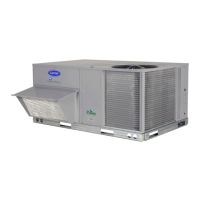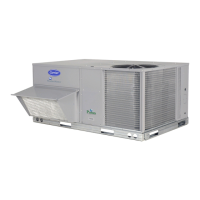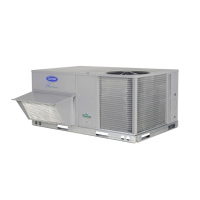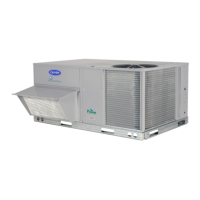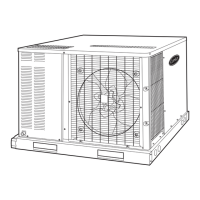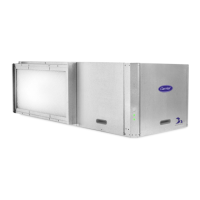7
Step 4 — Make Unit Duct Connections — Unit is
shipped for through-the-bottom duct connections. Ductwork
openings are shown in Fig. 6. Field-fabricated concentric duct-
workmaybeconnectedasshowninFig.7and8.
Attach all ductwork to roof curb and roof curb basepans.
Refer to installation instructions shipped with accessory roof
curb for more information.
Step 5 — Trap Condensate Drain — See Fig. 4 or
5 and 9 for drain location. Plug is provided in drain hole and
must be removed when unit is operating. One
3
/
4
-in. half cou-
pling is provided inside unit indoor air section for condensate
drain connection. An 8
1
/
2
in. x
3
/
4
-in. diameter nipple and a
2-in. x
3
/
4
-in. diameter pipe nipple are coupled to standard
3
/
4
-in. diameter elbows to provide a straight path down through
holes in unit base rails (see Fig. 10). A trap at least 4-in. deep
must be used.
Step 6 — Make Electrical Connections
FIELD POWER SUPPLY — Unit is factory wired for volt-
ageshownonnameplate.
When installing units, provide a disconnect of adequate size
per NEC (National Electrical Code) requirements (Table 2).
All field wiring must comply with NEC and local
requirements.
Route power lines through control box access panel or unit
basepan (Fig. 4 and 5) to connections as shown on unit wiring
diagram and Fig. 11.
Transformers no. 1 and 2 are wired for 230-v unit. If 208/
203-v unit is to be run with 208-v power supply, the transform-
ers must be rewired as follows:
1. Remove cap from red (208 v) wire.
2. Remove cap from orange (230 v) spliced wire.
3. Replace orange wire with red wire.
4. Recap both wires.
Operating voltage to compressor must be within voltage
range indicated on unit nameplate. On 3-phase units, voltages
between phases must be balanced within 2% and the current
must be balanced within 10%.
Use the following formula to determine the percentage of
voltage imbalance.
Percentage of Voltage Imbalance
EXAMPLE: Supply voltage is 460-3-60.
AB = 452 v
BC = 464 v
AC = 455 v
Determine maximum deviation from average voltage:
(AB) 457 – 452 = 5 v
(BC) 464 – 457 = 7 v
(AC) 457 – 455 = 2 v
Maximum deviation is 7 v.
Determine the percent voltage imbalance:
= 1.53%
This amount of phase imbalance is satisfactory as it is be-
low the maximum allowable 2%.
Unit failure as a result of operation on improper line voltage
or excessive phase imbalance constitutes abuse and may cause
damage to electrical components.
For vertical supply and return units, tools or parts could
drop into ductwork and cause injury. Install a 90-degree
turn in the return ductwork between the unit and the condi-
tioned space. If a 90-degree elbow cannot be installed, then
a grille of sufficient strength and density should be installed
to prevent objects from falling into the conditioned space.
Due to electric heater, supply duct will require 90-degree
elbow.
IMPORTANT: BE CERTAIN UNUSED WIRES ARE
CAPPED. Failure to do so may damage the transformers.
= 100 x
max voltage deviation from average voltage
average voltage
Average Voltage =
455 + 464 + 455
3
=
1371
3
= 457
Percentage of Voltage Imbalance = 100 x
7
457
IMPORTANT: If the supply voltage phase imbalance is
more than 2%, contact your local electric utility company
immediately.
NOTE: Do not drill in this area, as damage to basepan may result in
water leak.
Fig. 7 — Concentric Duct Air Distribution
(50HJQ016 Shown)
NOTE: Do not drill in this area, as damage to basepan may result in
water leak.
Fig. 6 — Air Distribution — Thru-the-Bottom
(50HJQ016 Shown)

